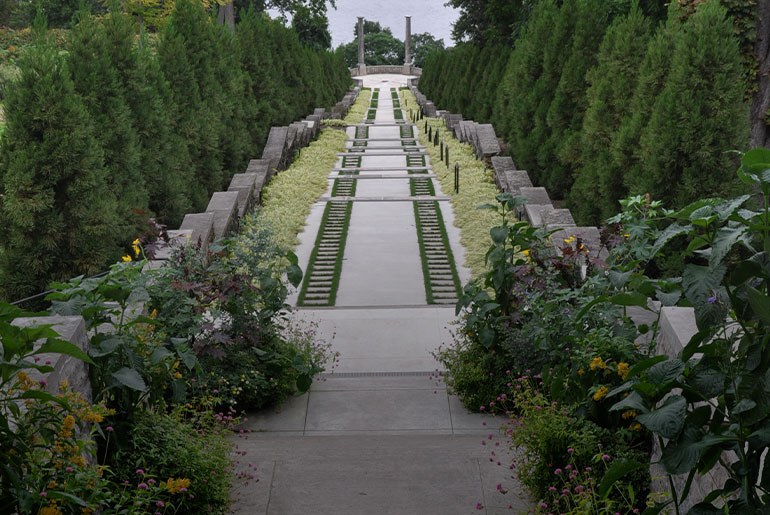John Lennon posed for photographs there. Isadora Duncan danced there. And composer Richard Strauss was one of the many luminaries who visited there.
“There” was paradise, or at least an earthly version of it, complete with Greco-Persian influences, which is only fitting as “paradise” is a Persian word for “an enclosed park.” In the case of the restored Untermyer Gardens Conservancy in Yonkers, the “enclosed park” of 43 acres is a garden walled on three sides that leads to neoclassical elements — arcades, temples and a small, open-air amphitheater guarded by two sets of twin Ionic columns topped with sphinxes; and watery ones — pools, canals and fountains — all overlooking the formidable Hudson River and chalky Palisades. Oh, yes and, of course, thousands of trees, shrubs, perennials and annuals as well as tropical and aquatic plants.
“The garden is always changing, letting in the view,” says Caroline Seebohm. “It is a combination of factors — the architectural elements, the gardens and that view — that have turned it into something unique.”
And something that Seebohm — a veteran garden and lifestyle author, born and raised in England, and now living in Titusville in the “garden state” of New Jersey — couldn’t resist. She was first introduced to Untermyer by photographer Curtice Taylor, with whom she did “Rescuing Eden: Preserving America’s Historic Gardens” (The Monacelli Press, 2015). Untermyer’s strange, sad, ultimately uplifting odyssey from Gilded Age glory to 1970s urban squalor and horror to resplendent 21st-century resurrection captivated her, and she knew it had to be part of “Rescuing Eden.” She also knew there was standalone book in this, the result being the recent “Paradise on the Hudson: The Creation, Loss, and Revival of a Great American Garden” (Timber Press, $27.95, 222 pages).
Untermyer the man
Central to its story is someone Seebohm found as fascinating as the place itself — Samuel Untermyer, the dapper, odontioda orchid-wearing, crusading New York attorney, friend and sometime foe of the rich and powerful alike, who even challenged automobile entrepreneur Henry Ford and his anti-Semitic publications. (Among his clients was Albert Einstein, who appreciated Untermyer’s discreet handling of his finances.)
“He was an extraordinary man…bright, ambitious, who took on cases no one would take, speaking for the underprivileged,” Seebohm says of his social justice activism. In the courtroom, she adds, “he had a quiet wit and a terrific, theatrical style” that drew the general public.
“I’m told that my profession is the law,” the Virginia-born Untermyer said in 1918. “But my real affection is for my greenhouse.”
As the 20th century dawned, Untermyer bought Greystone, the turreted 99-room mansion on the Hudson that had belonged to former New York Gov. Samuel J. Tilden. The 113-acre property would not sit idle.
“In those days,” Seebohm says, “they didn’t have landscape architects.” Extending his property to 150 acres, Untermyer hired William Welles Bosworth — responsible for the Italianate look of Kykuit, the sedately elegant estate of rival John D. Rockefeller in Pocantico Hills — with a mandate to create “the finest garden in the world.” Bosworth responded by creating a world that revealed even as it concealed, with outcroppings and Egyptian, English, Greek, Italian and Persian architectural elements, along with Paul Manship’s neoclassical sculptures, serving as a counterpoint to water displays, including fountains by Charles Wellford Leavitt, and vegetable and floral gardens as far as the eye could see. The Color Gardens, Seebohm says, were particularly noteworthy, each for a single color — the pink garden including snapdragons and hollyhocks; the blue garden, delphiniums and thistles; the red, geraniums and begonias; the white, Japanese and German irises and sweet Williams; and the yellow, chrysanthemums and cannas — among many other botanicals.
These gardens, inspired by the Impressionists and Postimpressionists, were meant to be enjoyed not just by the Untermyer family and their illustrious guests but by the public, which was admitted on Tuesdays. On one September day in 1939, 30,000 visited.
Resurrection
In a sense, that day in September 1939 — the month and year that World War II broke out in Europe — would serve as a kind of apotheosis for Untermyer’s gardens. As his health declined, he spent more time at The Willows, his Palm Springs estate, where he died on March 17, 1940 at age 82.
“1940,” Seebohm says, “was a terrible time for giving away Gilded Age mansions.” No one really wanted Greystone and its gardens — not the Untermyer family or the state (New York), the county (Westchester) and the city (Yonkers) he left it to in that order. Ultimately, Yonkers decided to accept 70 acres of the site, 16 for “Samuel Untermyer Park and Gardens.” By then furnishings inside and out of Greystone had been auctioned off — the mansion would be demolished in 1948 — and parcels sold off to developers. The remaining elements began to decline. When John Lennon posed for some photographs there in 1975 beneath the filigree wrought iron dome of the Corinthian-columned Temple of Love, he remarked that he should’ve worn jeans as the undergrowth had dirtied his new suit.
Worse was to come in the next two years as Untermyer Park became associated with “Son of Sam” serial killer David Berkowitz and tales of a dog-sacrificing cult. Meanwhile, time and nature reclaimed what vandals didn’t. Untermyer Park was becoming like something out of Thomas Cole’s painting series “The Course of Empire” (1833-36), a cautionary tale of civilization.
But Untermyer would have a different ending, thanks to Stephen F. Byrns, who as a child in Michigan liked to build and grow things. When the Princeton-educated architect tired of Manhattan, he moved to Yonkers and then Riverdale, where he became involved with Wave Hill — another grand Hudson estate that has been repurposed as an eco-cultural center (Page ?) — and befriended its director of horticulture, Marco Polo Stufano. But Byrns had already begun championing the revival of Untermyer, which had been expanded to 43 acres. At a Yonkers party in 2010, Byrns heard Untermyer’s fountains had been turned on. Something bubbled up inside him as well.
“I felt like something had hit me,” Seebohm quotes him as saying in the book. “The place combined history, gardens, architecture, horticulture and an important piece of America’s cultural and social heritage.”
Byrns enlisted the by-now-retired Stufano and the task of recalling Untermyer to life — as well as its crusading namesake — began with fundraising, news stories and tours as work proceeded on the Walled Garden, with its amphitheater, sphinx-topped columns, pool and canals; the Temple of Love, perched on a rocky outcropping with a waterfall; and the Vista, a step walkway leading down to the Hudson.
“This (year) marks the 10th anniversary of the Untermyer Gardens Conservancy,” says Byrns, now its president. “We have made enormous progress since 2011 and now have seven gardeners working, with more restorations slated to take place this year.” The cost to date — $2.2 million.
Untermyer, which has come full circle, is proof that destiny cannot be denied. It is still a place visited by the celebrated and the unsung alike. (British-Iranian journalist Christiane Amanpour, host of PBS’ “Amanpour and Company,” was honored there at a recent celebration of the Persian harvest festival, Mehregan.) It’s still overseen by an architect with an interest in gardens. It’s still a paradise on earth.
Up there in a different paradise, we imagine Samuel Untermyer is content.
A busy Untermyer season gets underway
Untermyer Gardens Conservancy is open 9 a.m. to 5 p.m. Mondays through Thursdays without reservations and noon to 6 p.m. Fridays through Sundays with free, timed online reservations.
In May, tours take place 11 a.m. to 12:30 p.m. Sundays, with the May 9, 23 and 30 tours focused on the history of the place and the May 16 tour focused on the gardens. Admission is $10.
On May 8, conservancy President Stephen F. Byrns leads the first in a series of three tours on the “Trees of Untermyer” from 10 to 11 a.m. ($20). (The other two Tree Tours will be in June.)
Programs include a drawing class from 10 a.m. to noon on May 15 and 22 ($40); and “Sunset Yoga” (for all abilities) from 7 to 8 p.m. on May 23 and 27 ($25). There are also Family Adventure Tours May 16 (Walled Garden), May 23 (Vista and Ruin Garden) and May 30 (Temple of Love and Dell) from 10 to 11 a.m. These are for ages 7 to12. The cost is $10 per child; those under age 2 and accompanying adult(s) are admitted free.
Capacity is limited. Social distancing and masks are required. All tours and classes must be reserved in advance at untermyergardens.org.






